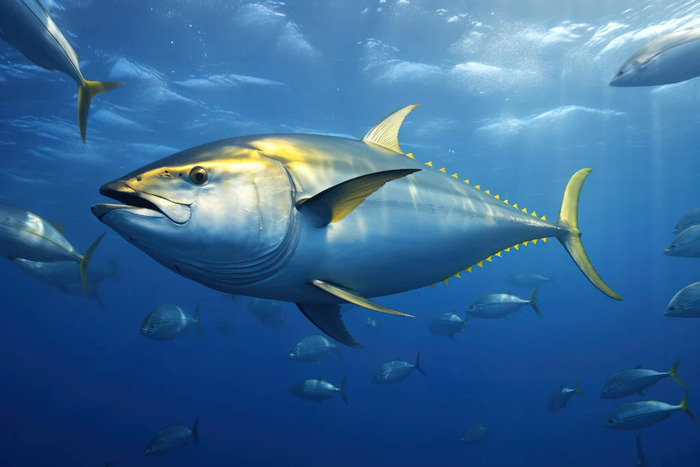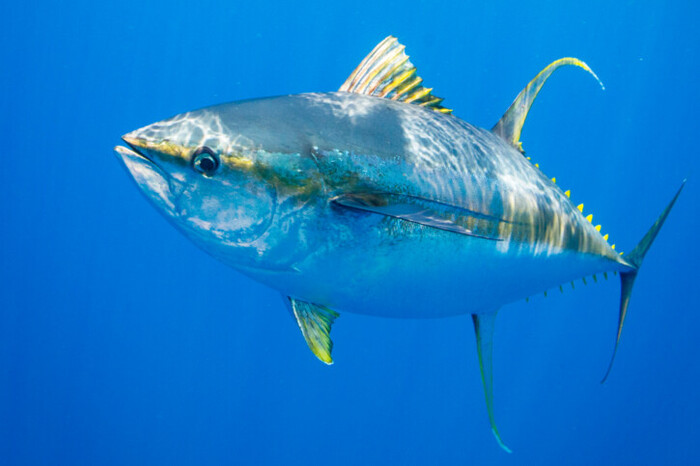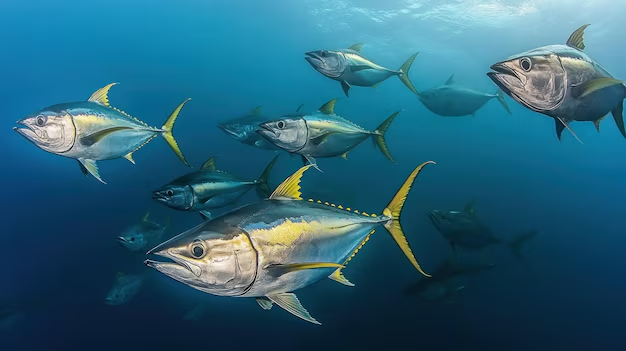Yellowfin tuna (Thunnus albacares) are one of the most important and commercially significant species of tuna in the world. Known for their speed, strength, and ability to navigate vast oceanic distances, yellowfin tuna are a key player in marine ecosystems and global fisheries. This article provides a detailed exploration of yellowfin tuna, from their taxonomy and physical characteristics to their migration patterns, ecological importance, conservation status, and the threats they face.

Scientific Classification of Thunnus albacares (Yellowfin Tuna)
| Category | Details |
|---|---|
| Kingdom | Animalia |
| Phylum | Chordata |
| Class | Actinopterygii (ray-finned fishes) |
| Order | Perciformes |
| Family | Scombridae |
| Genus | Thunnus |
| Species | Thunnus albacares |
Common Name: Yellowfin Tuna
Habitat: Warm tropical and subtropical oceans worldwide, especially in the Indian and Pacific Oceans.
Physical Characteristics: Known for its distinctive yellow dorsal and pelvic fins, and streamlined body shape, which aids in fast swimming.
Indeed, the Yellowfin Tuna (Thunnus albacares) is often marketed as ahi, a term derived from the Hawaiian language, where "ʻahi" refers to both Yellowfin and the closely related Bigeye Tuna (Thunnus obesus). This can sometimes create confusion, especially since the same name is used for different species in different contexts.
The species name albacares, which means "white meat," adds another layer of potential confusion. In English, albacore (Thunnus alalunga) refers to a completely different tuna species, recognized for its lighter, milder flesh. However, Yellowfin Tuna is officially called "albacore" in French, and in Portuguese, it's known as albacora.
To summarize:
Ahi: Commonly used for both Yellowfin and Bigeye Tuna in Hawaiian.
Albacares: The species name of Yellowfin, meaning "white meat."
Albacore: A distinct species (Thunnus alalunga), which in English refers to a different tuna.
Albacora: The Portuguese name for Yellowfin.
This naming overlap can often lead to confusion, especially in international trade and culinary contexts, where the same terms may refer to different species depending on the region or culture.
Yellowfin tuna belong to the family Scombridae and are part of the genus Thunnus, which includes other major tuna species like bluefin and bigeye tuna. They are classified under the suborder Scombroidei, which includes all the fast-swimming species of the mackerel and tuna family. Yellowfin tuna are considered one of the more widespread and commercially important species of tuna.
Yellowfin tuna have evolved numerous adaptations for survival in open-ocean environments. These include their streamlined bodies, specialized fins for fast swimming, and a highly efficient cardiovascular system, which supports their high metabolism and ability to sustain speed over long distances. Their evolution has been shaped by millions of years of oceanic pressure, making them among the fastest swimmers in the marine world.
Yellowfin tuna are easily identifiable by their bright yellow dorsal and anal fins, which are contrasted by their dark blue back and silver belly. Their body is torpedo-shaped, designed for speed and agility in the water. Adult yellowfin tuna can reach up to 2.5 meters (8.2 feet) in length and can weigh up to 200 kilograms (440 pounds), although most are much smaller.
Yellowfin tuna have a relatively short lifespan compared to other large fish species. They typically live up to 7 to 8 years, although some individuals may survive longer. The growth rate of yellowfin tuna is rapid in the early stages, with juveniles growing up to 10 centimeters per month, but it slows down as they reach maturity.
Yellowfin tuna are found in tropical and subtropical oceans worldwide. Their distribution spans across the Indian, Atlantic, and Pacific Oceans, particularly in the warm waters between 40°N and 40°S latitude. They are commonly found in the open ocean, often near the surface, but they are known to dive to depths of up to 500 meters (1,640 feet) in search of food.
Yellowfin tuna are highly migratory and prefer warm waters. They are often found in both nearshore waters and offshore environments, often in areas where upwelling currents bring nutrient-rich waters to the surface. These currents support the populations of small fish and squid, which yellowfin tuna prey upon. Their ability to navigate across vast distances makes them an apex predator in their ecological niche.
Yellowfin tuna are carnivorous and opportunistic predators. Their diet mainly consists of small fish, squid, and crustaceans. They have specialized adaptations that allow them to chase fast-moving prey. Yellowfin tuna are known to hunt in groups, using coordinated strategies to surround and catch schools of smaller fish. Their speed and agility make them highly efficient hunters.

Although yellowfin tuna are often seen alone or in small groups, they can form larger schools, especially during spawning or when feeding. They are social creatures, often observed traveling with other pelagic species like dolphins, sharks, or other tunas. Despite this social behavior, they are solitary when hunting.
Yellowfin tuna are highly migratory, often traveling thousands of kilometers across the oceans in search of food and suitable breeding grounds. Their migration is influenced by water temperature, food availability, and spawning cycles. They are known to migrate from warm equatorial waters to more temperate regions depending on the season.
Yellowfin tuna have a complex spawning migration, typically occurring in tropical and subtropical waters. They are known to spawn in the warm waters of the western Pacific, eastern Atlantic, and Indian Oceans. The spawning season varies depending on the region but often occurs in the warmer months when water temperatures are optimal for reproduction.
Yellowfin tuna are prolific breeders, with females capable of producing millions of eggs during each spawning season. The reproduction of yellowfin tuna is closely tied to their migration patterns, with spawning generally occurring in offshore, warm waters.
Spawning typically takes place in open waters, with eggs floating to the surface. The fertilized eggs hatch into larvae within a few days. The larvae are planktonic and remain in the water column until they reach juvenile stages. Once they mature, they begin migrating into deeper waters. This rapid growth and early maturity help ensure the survival of the species despite their high predation risk.
The conservation status of yellowfin tuna is a critical concern for marine ecosystems and global fisheries. The International Union for Conservation of Nature (IUCN) has listed yellowfin tuna as "Near Threatened" due to overfishing, habitat degradation, and the pressure placed on tuna stocks by commercial fisheries. As demand for tuna increases, particularly in the sashimi and canning industries, the sustainability of yellowfin tuna populations is at risk.
Various organizations, such as the Western and Central Pacific Fisheries Commission (WCPFC) and the International Commission for the Conservation of Atlantic Tunas (ICCAT), have implemented regulations to limit the catch of yellowfin tuna, establish fishing quotas, and promote sustainable fishing practices. However, illegal, unreported, and unregulated (IUU) fishing remains a significant problem.
The biggest threat to yellowfin tuna populations is overfishing. The high demand for tuna, especially in Asian markets, has led to unsustainable harvesting practices. Illegal fishing and lack of enforcement in some regions exacerbate the issue. In some areas, tuna stocks have been depleted, and there is concern that overfishing could lead to population collapse.
Changes in ocean temperatures due to climate change can also affect the distribution and migration patterns of yellowfin tuna. Warmer waters could alter the availability of prey and disrupt spawning cycles, while ocean acidification may affect the tuna’s prey species.

Yellowfin tuna are apex predators in their ecosystem, playing a crucial role in maintaining the balance of marine food webs. By controlling populations of smaller fish and squid, they help regulate the distribution of these species, thus maintaining the health of marine ecosystems. They are also an essential food source for larger predators like sharks, orcas, and seabirds.
Yellowfin tuna is one of the most commercially valuable fish species, with a global industry worth billions of dollars annually. It is a cornerstone of the global tuna fishing industry, particularly in the canning industry and the high-end sushi market. Sustainable management of yellowfin tuna populations is critical for the continued economic benefits that this species provides to coastal economies and global markets.
Here's a table displaying different types of Yellowfin Tuna and their relative value:
| Yellowfin Tuna Type | Price (per kg) | Notes |
|---|---|---|
| Bluefin Hybrid Yellowfin | $100 - $200+ | A hybrid variety of Yellowfin tuna crossed with Bluefin, prized for its rich flavor and texture, often used in high-end sushi and sashimi. |
| Fresh Premium Yellowfin | $50 - $100 | High-quality fresh Yellowfin tuna caught and sold for sushi-grade dishes, often from premium fisheries or sustainable sources. |
| Frozen Yellowfin (Sushi Grade) | $30 - $60 | Frozen tuna used for sushi and sashimi, typically from sustainable sources. Often a more affordable option than fresh varieties. |
| Yellowfin Tuna (General Market) | $10 - $30 | The standard Yellowfin tuna commonly sold in grocery stores or supermarkets. It is typically frozen or canned, with a more moderate price. |
| Canned Yellowfin Tuna | $3 - $6 | Generally the least expensive option, often used in sandwiches, salads, and prepared dishes. Prices vary based on the brand and quality. |
Note: Prices can vary significantly depending on factors such as the quality, region of harvest, size, and whether the tuna is wild-caught or farmed. Additionally, prices can fluctuate with market demand, especially in sushi-grade tuna markets.
Yellowfin tuna are an essential part of marine ecosystems and global fisheries, but they are facing significant threats from overfishing, climate change, and habitat destruction. Protecting this valuable species requires international cooperation, better enforcement of fishing regulations, and a commitment to sustainable practices. Understanding the biology, behavior, and conservation needs of yellowfin tuna is critical for ensuring their survival for future generations.
By promoting sustainable fishing, improving conservation efforts, and regulating tuna harvesting, we can protect yellowfin tuna populations and maintain their crucial role in marine ecosystems and global economies.
Key Takeaways:
Yellowfin tuna are migratory apex predators found in tropical and subtropical oceans.
Overfishing and illegal fishing remain the biggest threats to their populations.
Conservation efforts are underway, but international collaboration is essential for sustainability.
Yellowfin tuna play a vital role in marine ecosystems and have significant economic value globally.
animal tags: Scombridae
We created this article in conjunction with AI technology, then made sure it was fact-checked and edited by a Animals Top editor.